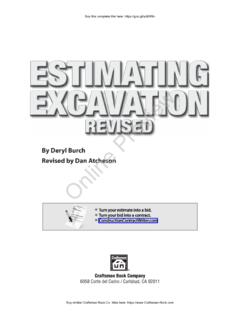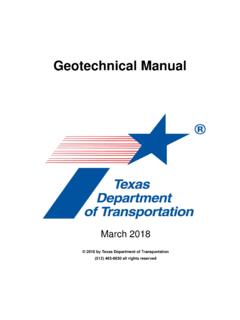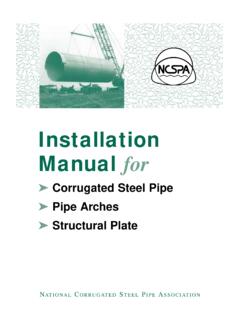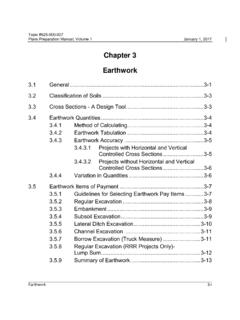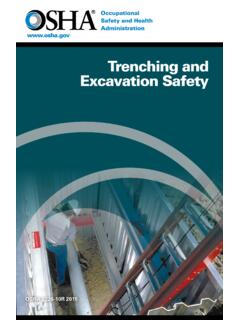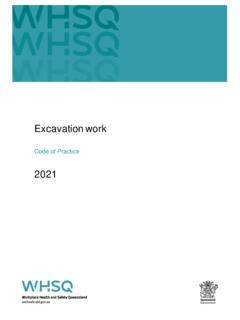Transcription of Excavation and Grading Handbook - Revised
1 Craftsman Book Company6058 Corte del Cedro / Box 6500 / Carlsbad, CA 92018bbyyNick CNick Capachi apachi&&JJohn Cohn Capachiapachi Buy this complete title here: But similar Craftsman Book Co. titles here: PREVIEWL ibrary of Congress Cataloging-in-Publication DataCapachi, Nick, 1934- Excavation and Grading Handbook / by Nick Capachi, John Capachi. -- ed. of: Excavation & Grading Handbook . : 978-1-57218-173-1 (pbk. : alk. paper)1. Excavation . 2. Roads--Design and construction. 3. Capachi, John, 1963- II. Capachi, Nick, 1934- Excavation & Grading Title. '52--dc222006015163 First edition 1978 Craftsman Book CompanySecond edition 1987 Craftsman Book CompanyThird edition 2006 Craftsman Book CompanyCover design by Patty KevershanGraphics by Devona Quindoy and Lori BoonLayout by Devona Quindoy and Nichole CampbellLooking for other construction reference manuals?Craftsman has the books to fill your toll-free 1-800-829-8123or write to Craftsman Book Company, Box 6500, Carlsbad, CA 92018for a FREE CATALOGof over 100 books, including how-to manuals,annual cost books, and estimating our Web site: this complete title here: But similar Craftsman Book Co.
2 Titles here: PREVIEW1 Understanding Road SurveyStakes.. 5 Survey stakes 62 Plan Reading.. 21 Subdivision plans22 Highway plans and cross sections 373 Grade Setting.. 51 Setting grade 52 Grade setting equipment53 Checking grade with swedes55 String lines 57 Laser levels 62 Crows feet 71 Staking cut and fill76 Sewer line projects794 Setting Grade Stakes Using aContour Plan.. 83 Reading a contour plan 84 Staking the area 865 Grading with Lasers, GPS and OtherSpecialized Equipment.. 93 Using a laser level for parking lots 94 Using a laser level for pads 95 Using a laser level for road projects 96 Using a laser level for trench work 98 Laser receivers on equipment101 Other on-board control systems103 Grading with GPS 1046 Road Building Equipment.. 117 Slip-form curb machines 117 Slip-form pavers 119 Profilers 121 Reclaiming machines125 Other specialty equipment 1267 Planning for Excavation .. 133 The equipment134 Soil conditions 1418 Excavating Rock.
3 145 Cutting slopes in rocky soil146 Ripping and excavating rock 148 Compacting fill with rock 1509 Excavating Subdivisions.. 155 Selecting the right equipment 156 Planning the excavation161 Erosion control 170 Grading and compaction 174 Fine trimming the subgrade17710 Excavating Commercial Sites.. 183 Take time for planning 184 Excavating an apartment or office complex 185 The Excavation begins 187 Curbs and paving19311 Highway Grading andExcavation.. 199 Staking a highway job 202 Beginning earthwork205 Checking the grade 208 Subgrade work 213 CCONTENTSONTENTSBuy this complete title here: But similar Craftsman Book Co. titles here: PREVIEW12 Widening Rural Roads.. 219 Minimize the inconvenience 220 Preparing the work area 221 The Excavation 22313 Building NarrowEmbankments.. 233 Making space for the equipment 234 Bringing in fill from above 237 Compacting and finishing 23714 Drainage Channels.. 241 Controlling water 242 Rebuilding a channel 246 New channel Excavation 24815 Unsuitable Material.
4 253 Testing for unsuitable soil 254 Excavating unsuitable material254 Plugging and bridging 257 The fill 259 Remedies for unsuitable soil problems260 Unsuitable soil around utility lines 26416 Compaction.. 271 Compaction testing272 Meeting embankment standards 276 Meeting subgrade standards 277 Selecting the right equipment28117 Curb and Sidewalk Grading .. 285 Curb stakes 285 Cutting curb grade 28918 Preparing Subgrade forAggregate.. 297 Rough trimming street subgrade 298 Fine trimming the subgrade 299 Trimming highway subgrade 30319 Aggregate Base.. 311 Placing aggregate in parking lots 313 Placing aggregate base on highways 320 Placing aggregate on subdivision roads 32520 Lime-Treated Base.. 337 Trimming the subgrade 337 Spreading the lime 338 Using lime to bridge unsuitable soil 341 Using cement instead of lime 34321 Asphalt Paving.. 347 Removing asphalt pavement 347 Asphalt paving equipment 354 Setting string lines 361 Planning the passes 361 Planning the dump 363 Placing asphalt with a paver 364 Paving with a spreader box 376 Scheduling asphalt trucks 377 Rolling the spread 379 Applying the tack coat 382 Patch paving and trench paving 384 Chip seal 38822 Trenching and Pipe Laying.
5 393 Trenching for water pipe 393 Laying water pipe 395 Trenching for sewer pipe 402 Laying sewer pipe 408 Pressure testing sewer pipe411 Repairing broken sewer pipe 416 Trenching for drain pipe 41723 Trench Shoring, Shields andSloping.. 433 Hydraulic shoring434 Shields 43824 Constructing Manholes.. 443 Manhole bottoms 443 Setting the barrels450 Setting manhole castings 45425 Underdrains, Culverts andDowndrains.. 459 Underdrains 459 Culverts 460 Downdrains 462 Appendix A. Equipment operating tips 467B. Glossary 491C. Abbreviations 497 Answers to Chapter Questions.. 499 Index.. 501 Buy this complete title here: But similar Craftsman Book Co. titles here: PREVIEWTThis manual is a practical guide to Excavation , Grading , paving andpipelines. My aim in writing is to provide information on the bestmethods available to increase your productivity in, and knowledge of, thisvery important field. This book can benefit anyone in the constructiontrade, from beginners just starting out to contractors with years ofexperience whether you work in this field, or you just need informationto help you understand the process.
6 It s written in simple terms andcovers each step of the Excavation and Grading process, from how to readand understand grade stakes, through paving, laying pipe and cuttingdrainage channels. Since the mid 1970s, when my first Grading and Excavation book waspublished, there have been many changes in construction methods andequipment. Adapting lasers, sonar, and GPS to control the equipment tocarry grade is by far the biggest change I ve dealt with in this field. Usingsonar and slope control on graders to fine trim has greatly increasedUUNDERSTNDERSTANDING ANDING RROAD OAD SSURVEY URVEY SSTTAKESAKES11 Buy this complete title here: But similar Craftsman Book Co. titles here: PREVIEW66 Excavation & Grading Handbook production in the last few years. The operator using a GPS has the preciselocation where he is working right on his screen, showing the parametersof the lot pad and the elevation needed. GPS is now used on dozers,scrapers and compactors, and is also used for surveying.
7 I ll be coveringGPS in detail in a later chapter in the the trenching department, the biggest change is that backhoes havereplaced most trenchers, and hoes with compaction wheels haveeliminated most trench the first four chapters of this book we ll cover the basics: readingand following survey stakes, understanding Excavation plans, and howexcavation contractors use contour line drawings. If you ve been workingin the Excavation and Grading business for a while, most of what you readin the first few chapters you probably know already. But if you need abrush-up on plan reading and stake markings, or if you re new in the field,these chapters explain it in terms I use throughout the let s start at the beginning with surveying and staking. Everyone the inspector, superintendent, foremen and Grading equipmentoperator, needs a good understanding of how surveyors stake the job. Notunder-standing the stakes is like having the specifications and not beingable to read. Today, most large jobs and many small ones are excavatedusing GPS to guide equipment.
8 And even fewer stakes will be used in thefuture, making the stakes that areset more important than ever to basic information on the stakes has changed little in the last few , the way the surveyors compute that information has StakesExcavation for roads, buildings and pipelines begins with a survey ofthe area where the Excavation will be done. A survey crew working for theengineering firm that s designing the project will set out stakes and hubsthat identify points on the construction plans. When a precise distance orelevation is needed, a surveyor s tack on top of the hub establishes thepoint from which elevations and distances are each hub there will be an information stakemarked insurveyor s code. It explains the grades at various distances from the hubBuy this complete title here: But similar Craftsman Book Co. titles here: PREVIEWUNDERSTANDING ROAD SURVEY STAKES77 FFiigguurree 11--11 Reading cut stakesFrontCut cross sectionGrade setter s stake2-foot bootSurveyor information stakeSurveyor s hubEL :1 SlopeDitchRSBackSideSideHPCut areaEPOriginal +50540SE 2%2:1 EL 8340or other reference stake or point.
9 It s essential that you know how to readthe markings on these information stakes and follow the instructions theyprovide. The surveyor may write on one or all sides of the StakesThe stakes are usually called cut, fillor slopestakes, depending on the typeof Excavation required. Figure 1-1 shows the kind of markings you ll find on aninformation stake. In this case, we re looking at a cut stake for a road54 feet2%4'' AC4'' ABFillCLCLBuy this complete title here: But similar Craftsman Book Co. titles here: PREVIEW88 Excavation & Grading Handbook Excavation . The front, back and both sides of a cut stake are shown in thefigure. Below the stake there s a cross section drawing of the existing gradeand final road grades that are described on the stake. Refer to the drawing as Iexplain the markings on the information stake in the first at the stake labeled frontin the upper left of Figure s the front of the information stake. The RSat the top of the stakemeans that there s a reference stake to be established, and that referencestake is the point from which measurements and elevations are taken.
10 Thelocation of the reference stake is the point that the projected cut slopemeets or catches original ground, also referred to as a catch point. Findthe reference stake in the drawing. It s labeled RSand it s in the upperleft-hand corner of the drawing. Below the letters RSon the informationstake you see C-10. Below that you see a diagonal line and 50. Thesemarkings above and below the diagonal line identify the amount of cutand distance needed to establish the correct grade at the reference number above the diagonal line is the elevation and the numberbelow the diagonal line is the distance. In this case, the information stakeshows a cutof foot (below the level of the surveyor s hub) to be feet from the hub for the RS surveyors may use RPinstead of RS. RPmeans reference it exactly the same as the RS. Notice that distances and elevations are measured in feet and tenths(or hundredths) of a foot, not feet and inches. The small number above thesmall horizontal line shows decimals of a foot.
